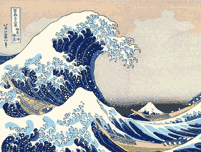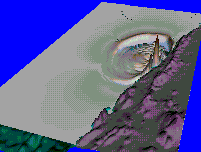|
Recent Earthquakes
Felt An
Earthquake?
Historical Intensity Maps
South Asia Seismicity
Great Earthquakes
Tsunamis & Seiches
GSHAP Hazard Maps
Seismology Links
Be Earthquake Safe!

Advertisement
Advertisement
Advertisement
|
|
|
|
 The
infamous offspring of undersea earthquakes, tsunamis conjure
images of towering waves Though towering waves rarely accompany
tsunamis, they are an
immediate secondary threat to coastal and low-lying communities
following offshore or coastal earthquakes. The word "Tsunami" is
Japanese for "Harbour Wave". They are often wrongly called "Tidal
Waves" and have nothing to do with tides. Most are generated by
shallow earthquakes in the sea or by temblors near the coast that
can set off underwater landslides. Volcanic eruptions scan also
cause tsunamis. The 2004 earthquake off Sumatra is the deadliest
earthquake in history with more than 1,00,000 fatalities around
the Indian Ocean basin. Other deadly tsunamis includes the 1755
Lisbon (60,000), 1883 Krakatoa (30,000) and 1896 Meiji Sanriku
(27,000). The
infamous offspring of undersea earthquakes, tsunamis conjure
images of towering waves Though towering waves rarely accompany
tsunamis, they are an
immediate secondary threat to coastal and low-lying communities
following offshore or coastal earthquakes. The word "Tsunami" is
Japanese for "Harbour Wave". They are often wrongly called "Tidal
Waves" and have nothing to do with tides. Most are generated by
shallow earthquakes in the sea or by temblors near the coast that
can set off underwater landslides. Volcanic eruptions scan also
cause tsunamis. The 2004 earthquake off Sumatra is the deadliest
earthquake in history with more than 1,00,000 fatalities around
the Indian Ocean basin. Other deadly tsunamis includes the 1755
Lisbon (60,000), 1883 Krakatoa (30,000) and 1896 Meiji Sanriku
(27,000).
What causes a tsunami?
Shallow undersea earthquakes
are responsible for most tsunamis though at time landslides
triggered by smaller seismic events can also generated potentially
lethal waves. Strong earthquakes cause a displacement of the
crust. When they occur underwater, this crustal movement
disturbs a large volume of water like a giant paddle and ripples
spread out in all directions at speeds of 600-800 kilometres per
hour, comparable to commercial aircraft. In the open ocean, they
go unnoticed but once they reach shallower waters they slow down
and begin to crest. The waves thus given rise to are known as
"Tsunamis". They
are scientifically described as a series
of very long wavelength ocean waves caused by the sudden
displacement of water by earthquakes, landslides, or submarine
slumps and are mostly caused by earthquakes of magnitude 7.5 or
greater. Small
earthquakes have also been known to generate tsunami activity but
the effects of these tend to be localized i.e. confined to a small
region.
|
|
|
Historical Tsunamis in south Asia
The deadliest tsunami prior to 2004, was in
November 1945 which
originated off the Makran coast in Pakistan
and caused deaths as far as Mumbai. One of the earliest known
tsunamis was experienced by the fleet of Vasco da Gama as they
approached Dabhol, on the Konkan coast of Maharashtra in 1524.
Most historical tsunamis that affected south Asia were
basin-wide events but none approaching the scale of destruction
caused by the the December 2004 Indian Ocean tsunami. |
|
|
Seismic Seiches
(Pronounced:
Sai-Shhh)
Long period movement of water can also be produced in lakes
and reservoirs by large, usually distant, earthquakes, and sometimes
by strong winds. In the late nineteenth century a Swiss professor,
F.A. Forel made a systematic study of this type of a water wave,
which he called a "seiche".
Seiches are described as "a standing wave in a closed body of water
such as a lake or bay". A seiche can be characterized as the
sloshing of water in the enclosing basin. The permanent tilting of
lake basins caused by nearby fault motions has produced very
energetic seiches. Seiches caused by earthquakes are termed as
seismic seiches, a term coined by Anders Kvale in 1955 to describe
oscillations of lake levels in Norway and England caused by the
M8.6 1950 Chayu
earthquake. Seismic seiches have been
reported after numerous earthquakes in south Asia. The M7.6
Bhuj and M7.6 Kashmir earthquakes
both caused seismic
seiches as far as Bangladesh
while the
M8.1 1934 Bihar earthquake caused a seismic seiche in Lake
Vembanad, Kerala, capsizing many canoes. Great earthquakes in
Sumatra have also produced noticeable seiches in part of the
peninsula. The 1861 Sumatra earthquake, also caused seiches that
were noticed at many locations in Bengal and Orissa, including
Kolkata. The M9.1 Sumatra-Andaman earthquake in 2004 and the
M8.7 Nias earthquake in 2005, also generated energetic
seiches in eastern India, Bangladesh and Thailand. The only known
fatality attributed to seismic seiches in south Asia occurred in
West Bengal's Nadia district during the 2004 Sumatra-Andaman
earthquake when an early morning bather was swept away by unusually
large waves that formed in the Jalangi River near Jatrapur.
Landslide induced waves
 Sometimes
a landslide or an avalanche into a body of water, can also trigger
local water waves. One of the most famous wave of this kind occurred
on 9 July, 1958. A large earthquake struck a remote area of southern
Alaska and caused a landslide into a 11 kilometre long bay known as
Lituya Bay. The quake dislodged an estimated 30 million cubic metres
of rock and sent it cascading into the bay, from a height of 900
metres. A massive wave of water was generated. It surged across the
narrow bay and denuded nearly mountain slopes up
to a height of 500 metres. 5 people were drowned but others
had miraculous escapes like Bill and Vivian Swanson. They had
anchored their fishing boat, the Badger, just inside Lituya bay's
opening to the sea, behind a 1.5 kilometre spit called the La
Chaussee Spit. After feeling the earthquake and watching the
landslide they watched in terror as the wave raced towards them.
Their boat was washed up onto the crest of the wave, backward, and
was swept over the 140 metre wide spit. The Swansons were lucky and
lived through the experience. In 1998, a strong
earthquake off the coast of Papua New Guinea set off an underwater
landslide that spawned a 10-metre tsunami. The wave struck the coast
of West Sepik province and devastated villages near the Sissano
Lagoon killing several hundreds. Sometimes
a landslide or an avalanche into a body of water, can also trigger
local water waves. One of the most famous wave of this kind occurred
on 9 July, 1958. A large earthquake struck a remote area of southern
Alaska and caused a landslide into a 11 kilometre long bay known as
Lituya Bay. The quake dislodged an estimated 30 million cubic metres
of rock and sent it cascading into the bay, from a height of 900
metres. A massive wave of water was generated. It surged across the
narrow bay and denuded nearly mountain slopes up
to a height of 500 metres. 5 people were drowned but others
had miraculous escapes like Bill and Vivian Swanson. They had
anchored their fishing boat, the Badger, just inside Lituya bay's
opening to the sea, behind a 1.5 kilometre spit called the La
Chaussee Spit. After feeling the earthquake and watching the
landslide they watched in terror as the wave raced towards them.
Their boat was washed up onto the crest of the wave, backward, and
was swept over the 140 metre wide spit. The Swansons were lucky and
lived through the experience. In 1998, a strong
earthquake off the coast of Papua New Guinea set off an underwater
landslide that spawned a 10-metre tsunami. The wave struck the coast
of West Sepik province and devastated villages near the Sissano
Lagoon killing several hundreds. |
|
|
Further information
(External links will open in new window):
International Tsunami Warning Centre
|
Pacific Tsunami Warning Centre
1896 Meiji Sanriku
Tsunami
»
JST Failure Knowledge Database
|
Sanriku Earthquakes
1958 Lituya Bay
Tsunami
»
USC Tsunami Research Group
|
Historical tsunamis in Lituya Bay
1998 Aitape
Tsunami
»
USC Tsunami Research Group |
USGS Tsunami simulation
2004
Boxing Day Tsunami
»
NIO Dona Paula |
NOAA |
USGS Tsunami simulation |
|